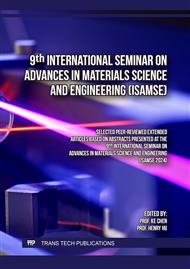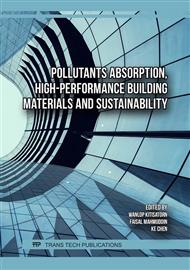p.43
p.49
p.59
p.67
p.77
p.87
p.97
p.103
p.111
Polyvinylidene Fluoride Nanofiber Murray Membrane for Quick Oil Absorption
Abstract:
With the rapid advancement of global industrialization, there is an increasing year-on-year demand for oil in society. The occurrence of oil spills during the processes of development, refining, and transportation has become an urgent issue that needs to be addressed. Electrospun fiber separation using selective oil/water absorption represents a relatively new yet promising technology. However, despite the lipophilic nature of the membrane for oil absorption, the rate of oil absorption is slow. There are still challenges in meeting the needs of developing communities. The plant employs a strategy of multi-branching with narrowed pores, which serves to enhance the efficiency of water and nutrient transfer. Inspired by plant transpiration, we adjusted the parameters of electrospinning and constructed a PVDF biomimetic nanofiber membrane with gradually reduced pore size through a bottom-up layer-by-layer spinning strategy. This PVDF biomimetic nanofiber membrane conforms to Murray's law. The experimental results showed that the oil absorption of carbon tetrachloride by PVDF Murray membrane was 3.06 g/g. Significantly, the PVDF Murray membrane demonstrates rapid adsorption of the oil slick (0.3 mL, n-hexane) in just 13s, as compared to 24s without the Murray structure. Therefore, the one-step preparation of the PVDF Murray membrane indicates a promising potential for its future application as a sustainable and quick oil-absorbent membrane.
Info:
Periodical:
Pages:
111-120
Citation:
Online since:
December 2024
Authors:
Keywords:
Price:
Сopyright:
© 2024 Trans Tech Publications Ltd. All Rights Reserved
Share:
Citation:



